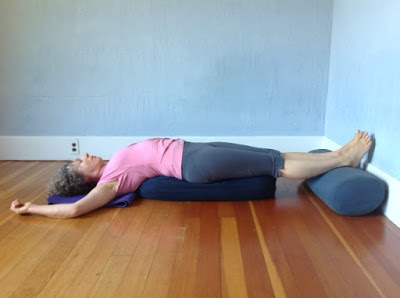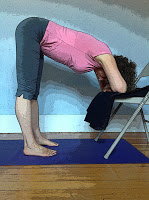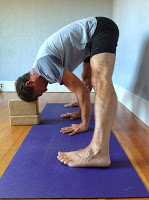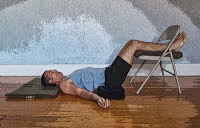by Nina
 |
| Supported Bridge Pose with Straight Legs |
Yesterday I gave my regular private lesson to Richard, a very lovely and compassionate older man who works as a psychotherapist. He has a number of physical problems I’ve been helping him with, though I’ve also tried to help him with his insomnia (he tends to be somewhat anxious). It’s very rewarding to teach him as he says he always feels better, both physically and emotionally, after our sessions.
Although we’ve been focusing on core strength lately, he showed up saying, “I really need to work on stress management today!” He explained that due to the divisive election, his therapy sessions in Berkeley, California, had been particularly stressful for him, as all his clients needed to talk about it. So election discussion for him was going on all day long, every day! And of course he had no choice but to let his clients talk about whatever they needed to. But his stress levels were worse than usual, and his blood pressure levels had actually gone up!
Well, as many of you may know by now, stress management is one of my areas of expertise, so I immediately came up with a new sequence for him. Since he tends toward anxiety, I knew that restorative yoga, meditation, and breath work wouldn’t be that good for him (he gets anxious attending to his breath), so I said, “We’ll do a supported inversion practice today.” (See All About Supported Inversions for information on these poses and Why You Should Love Your Baroreceptors for why they work.)
I’ll give you the sequence at the end of this post. But the thing I really wanted to share with you is that as he started to do the sequence, and it was obvious to both of us that he was starting to relax, I said to him, “Please don’t feel guilty about taking this time to relax and restore yourself. It will not only be beneficial for you, but it will allow you to do a better job in the important work you do.”
And he smiled at me and replied, “So it’s like ‘Put on your own oxygen mask first’?”
“Yes, that’s it!” I said. So the takeaway from that is that doing what you need to stay calm, clear, and focused isn’t an indulgence; it’s the best way to keep yourself strong for the work you are committed to, whether it’s political action, volunteering for your favorite cause, or caring for a loved one.
As Richard went through the practice, I kept checking in with him how he was feeling and which poses were working for him. I know from experience that everyone is different in which poses they enjoy, probably depending on physical issue and body types (and who knows what else). I wanted to make sure that if poses wasn’t helping, he should come out. And if a pose was really working well, I’d leave him in it longer. To my great surprise, a pose I’d never taught him before, Supported Bridge pose with Straight Legs, felt absolutely wonderful to him! (I thought maybe because he has back issues he wouldn’t enjoy it.) So we both learned something important. And though my plan was to have him stay in that pose for 5 minutes, I asked him if he wanted another 5, and he said, yes, please! (I photographed him in the pose so he could easily recreate the propping we used at home.)
So the takeaway from that is that if you’re doing supported inverted poses (or restorative poses for that matter), it’s worth experimenting with them all because you really never know which one is going to be the most effective for you. Just go in with an open mind, and be willing to come out of the poses that don’t actually help.
If you have the time and want to share what you do to stay calm and focused during challenging times, please leave a comment!
Richard’s Supported Inversion Sequence
I told him if he does this sequence (or any of the poses) at home to listen to relaxing music to take his mind off his anxious thoughts.
1. Reclined Leg Stretch version 1, to stretch the legs for the Supported Downward-Facing Dog pose and Supported Standing Forward Bends. 1.5 minutes each side.

2. Half Downward-Facing Dog pose, classic version, to stretch the shoulders and lengthen the torso to prepare for the same supported inverted poses. 1.5 minutes (with me assisting)

3. Supported Downward-Facing Dog pose, with head on a bolster plus blanket (he is on the stiff side) and a strap around the arms. For 2 minutes (this was challenging for him so I had him come out early.)

4. Standing Forward Bend, version 4, forearms and head on a chair seat). For 3 minutes (he loves this).

5. Widespread Standing Forward Bend, forearms and head on a chair seat. For 3 minutes (new to him, but he enjoyed it).

6. Supported Bridge Pose with straight legs. For 10 minutes.

6. Easy Inverted Pose. For 10 minutes. With a body scan spoken by me.

Yes, this sequence really helped him!
Follow Yoga for Healthy Aging on Facebook ° To order Yoga for Healthy Aging: A Guide to Lifelong Well-Being, go to Amazon, Shambhala, Indie Bound or your local bookstore.


Hi Nina, yes, these are such trying times for all of us. thank God we have our meditation, Pranayama, and yoga practice to help calm our nerves and anxiety. My recent favourite asana was taught to me by an Iyengar friend /teacher who learned this from Colleen Saidman and Rodney Yee at their TT this summer. It is a supported Supta Baddha Konasana in Savasana. Although this is not a supported Inversion asana, it has been one of my faithful friends since November 8th. I try to practice it for 15 minutes. Put one bolster across the middle of your mat. Place a three folded blanket on top of the bolster. Place 2 bricks next to each other on the other side of the bolster. Fold your mat on top of the two bricks like a burrito. Place a blanket for under the neck and lay down in front of the bolster. Place your feet in Buddha Konasana on top of the bricks and your knees on the top of the bolster. Move your buttocks close to the bolster. Lay down on the the mat and place something over your eyes. If your knees do not touch the blanket on top of the bolster, add another one. For smaller students, they may need tow more bricks to create height to support their feet. Voila! enjoy!
Thanks for taking the time to comment! Wish I could see a photo of this pose! But it sounds to me like your legs are much higher than the rest of your body. And this would actually create some inversion effect, as blood from your legs would flow down toward your heart. So that may be partly why it's so soothing (although Reclined Cobbler's pose in general is soothing).
Thanks for all of this, both of you. :) Carrying all of this in my toolbox.
I enjoyed this blog entry in particular because it had to do with yoga poses that are helpful for anxiety. Because I practice at home with books, only occasionally attending classes, it was heartening to discover that all the poses you discussed for calming the anxious mind were those that seemed to naturally evolve over the years in my own practice. (This was also the case with the poses recommended for people with osteoporosis). You mentioned that for some people, focusing on the breath can increase anxiety. Though not always the case, this has frequently been true for me in the past and in fact, has caused some confusion since most of what one reads states that breathing and meditating actually calms anxiety. It is only recently that I have come across any mention of the opposite. Can you perhaps, write a blog entry about this very situation, which seems so contradictory to the practice of yoga and breath work? It would be great to read something about this and to find some additional recommendations for a yoga practice that includes some options for those whose anxiety is heightened rather than soothed by meditation. Thank you. Lisa
This comment has been removed by the author.
Thanks for your comment! I will try to write something about this in the future. However, the short answer is: if it doesn't work for you, it doesn't work for you. So my student finds that breath awareness makes him anxious. Even though that is supposedly calming, since it makes him anxious I give him something else to do! So in this case, it's not a rule about yoga and anxiety so much as a rule that: if it doesn't work for you, don't do it. Also, I have written quite a bit about anxiety on the blog already. This post has links to a lot of other posts on the topic: http://yogaforhealthyaging.blogspot.com/2014/07/10-ways-to-soothe-anxiety-with-yoga.html
You can use the search function on the blog to find many posts on anxiety. But you might also like this one: http://yogaforhealthyaging.blogspot.com/2014/04/when-relaxing-isnt-relaxing.html